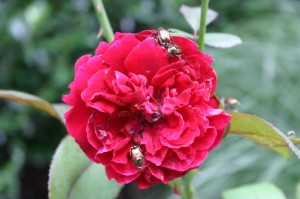 Japanese Beetles The Japanese beetle is probably the most devastating pest of urban landscape plants in the eastern United States. Japanese beetles were first found in this country in 1916, after being accidentally introduced into New Jersey. Until that time, this insect was known to occur only in Japan where it is not a major pest.
Japanese Beetles The Japanese beetle is probably the most devastating pest of urban landscape plants in the eastern United States. Japanese beetles were first found in this country in 1916, after being accidentally introduced into New Jersey. Until that time, this insect was known to occur only in Japan where it is not a major pest.
The eastern US provided a favorable climate, large areas of turf and pasture grass for developing grubs, hundreds of species of plants on which adults could feed, and no effective natural enemies. The beetle thrived under these conditions and has steadily expanded its geographic range north to Ontario and Minnesota, west to Iowa, Missouri and Arkansas, and south to Georgia and Alabama.
Japanese beetles feed on about 300 species of plants, devouring leaves, flowers, and overripe or wounded fruit. They usually feed in groups, starting at the top of a plant and working downward. The beetles are most active on warm, sunny days, and prefer plants that are in direct sunlight. A single beetle does not eat much; it is group feeding by many beetles that results in severe damage.
